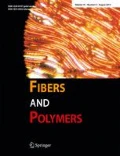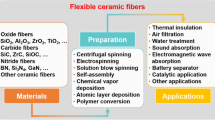Abstract
To test and clarify the stability of afterglow performance of luminescent fibers can accelerate the step of the commercialized application on luminescent textiles. This work investigated the possible effects of a number of working conditions on the afterglow characteristics of luminous fibers. The fibers in our studies did not show any significant change in their afterglow brightness and duration after storage for 12 months under conditions of constant temperature and humidity, after 5 hours of light exposure, or soaking in water for 4 hours. The insignificant decay appears to follow the same mechanism. Thermal perturbation seemed to cause some changes to the initial brightness and decay time with the best performance being observed at about 80°C. Moreover, contact with acid or base for 5 minutes only resulted in slight reduction of the afterglow brightness. Our studies thus indicate a high degree of stability of the afterglow performance of the luminous fibers used.
Similar content being viewed by others
References
Z. T. Zhang, F. Zhang, and Z. L. Tang, J. Funct. Mater., 30, 295 (1999).
X. F. Guo, M. Q. Ge, and J. M. Zhao, Fiber. Polym., 12, 875 (2011).
A. J. Lenus, K. G. Rajan, M. Yousuf, D. Sornadurai, and B. Purniah, Mat. Lett., 54, 70 (2002).
L. L. Peng, Y. Y. Luo, Y. Dan, L. Zhang, Q. Zhan, S. M. Xia, and X. L. Zhang, Colloid Polym. Sci., 285, 153 (2006).
A. A. Hamza, I. M. Fouda, M. A. Kabeel, and H. M. Shabana, Polym. Test., 8, 201 (1989).
M. Q. Ge, X. F. Guo, and Y. H. Yan, Text. Res. J., 82, 677 (2012).
Y. N. Xu, MS Thesis, Jiangnan University, 2008.
J. M. Zhao, X. F. Guo, Y. N. Xu, and M. Q. Ge, J. Text. Res., 29, 1 (2008).
J. S. Zhang and M. Q. Ge, J. Text. Res., 34, 12 (2013).
Z. P. Yang, Y. Yang, and S. C. Zhu, J. Chin. Ceram Soc., 32, 1050 (2004).
X. F. Guo and M. Q. Ge, Text. Res. J., 83, 1263 (2013).
D. F. Zhou, C. S. Shi, and Z. M. Qi, J. Chin Rare Earth Soc., 24, 18 (2006).
D. Haranath, V. Shanker, H. Chander, and P. Sharma, Mat. Chem. Phys., 78, 6 (2002).
H. Aizawa, T. Katsumata, J. Takahashi, and K. Matsunaga, Rev. Sci. Instrum., 74, 1344 (2003).
X. W. Zan, B. Feng, Y. M. Fu, and Z. M. Zhou, Transducer and Microsystem Tech., 28, 8 (2009).
Y. H. Lin, Z. T. Zhang, and Z. L. Tang, Mat. Chem. Phys., 70, 156 (2001).
X. F. Guo and M. Q. Ge, J. Text. Res., 34, 9 (2013).
Author information
Authors and Affiliations
Corresponding author
Rights and permissions
About this article
Cite this article
Guo, X., Zhang, K., Zhang, H. et al. Working Conditions on the Afterglow Characteristics of Rare-earth Luminous Fibers. Fibers Polym 19, 531–537 (2018). https://doi.org/10.1007/s12221-018-7376-z
Received:
Revised:
Accepted:
Published:
Issue Date:
DOI: https://doi.org/10.1007/s12221-018-7376-z




